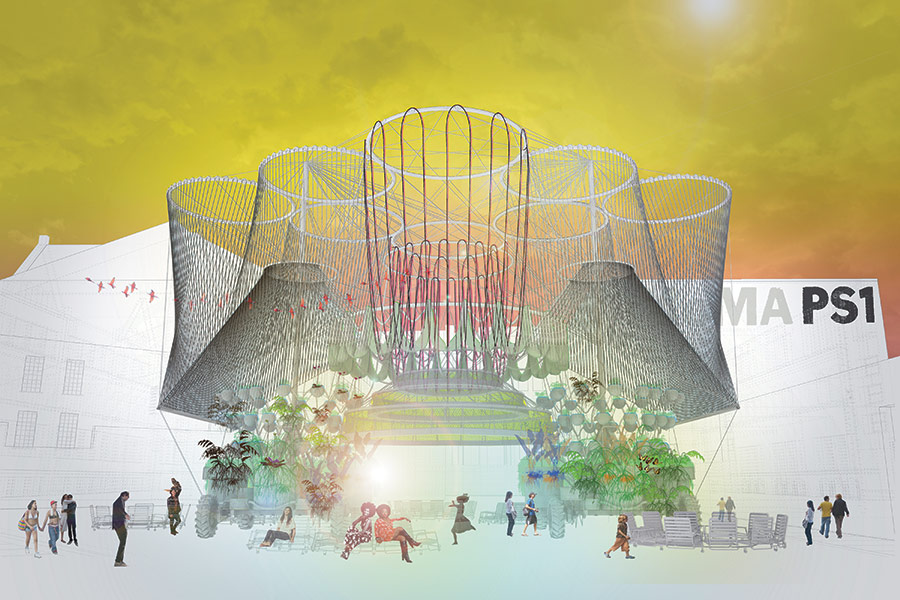
I’ve noticed a trend lately of architectural projects getting prizes and other attention based- for public consumption at least- on some aspect of their performance. Looking at such projects, it’s often obvious that this function is either trivial or beside the point, given their formal interest. Why has function- performance more generally- become the dominant narrative of architectural value?
To see what I mean, consider COSMO H2O, a project by architect Andres Jaque and his firm Office for Political Innovation (see photos). This project was just announced as the winner of the prestigious Museum of Modern Art’s Young Architects Program and will be installed at MoMA PS1 in Long Island City, Queens this summer. The main virtue of the project, according to its announcements, is that it purifies water. According to The Architect’s Newspaper, submissions were required to “provide shade, seating, and water for the museum’s Warm Up summer music series—a season-long dance party—while also addressing environmental issues.” (The subordination of environmental concerns to a “season-long dance party” evident in this statement shall pass without comment for now.)
However, the project purifies a trivial amount of water- 3000 gallons every four days. For reference, the average American family uses about 300 gallons a day according to the EPA. Even allowing for our profligate and unsustainable level of water consumption, 750 gallons a day is the proverbial drop in the bucket in the context of the real problem. Jaque claims that “COSMO is intended as a prototype that can be easily reproduced around the world to deliver drinking water where it is needed most.” But given its minuscule output, COSMO is not a prototype of useful practical water purification system. Perhaps it’s scalable, but no mention is made of this crucial fact if indeed it is true.

The point is not to quibble with the architect’s claims or MoMA’s selection of the project. What I find interesting is the importance assigned this token function. A quick look at the renderings (see above) shows very different, and more plausible, reasons why the project was chosen: it’s a playful, fanciful object that promises visual delight, especially at night (although to get the effect shown in the night rendering, the installation would have to take place in the Hayden Planetarium, not PS1). Of course, MoMA could not give this as the reason for its selection. This august institution must give more serious grounds for its decisions.
The MoMA committee could have tried to evaluate the form itself in artistic terms. It does so with the paintings and sculptures it exhibits and has done so with works of architecture in the past. Why not in this instance? I’d suggest there are two forces at work. One is the bewildering nature of recent developments in architectural design. Parametric design tools and computer-driven fabrication have unleashed a tidal wave of seductive forms that have, for the moment at least, overwhelmed the collective critical capacities of the masters of the artistic universe. Yet critics are rightly hesitant to judge this new “style” and institutions neglect it at the risk of appearing out of touch.
Second, we are experiencing a resurgence of a restrictive type of functionalism. Everything must now have a performative justification. This tendency is always lurking in American culture- we have always been suspicious of anything not absolutely required to achieve some practical purpose. Why it has flared recently is open to speculation. I would suggest that the increasing dominance of technology in our culture and economy is partly responsible. A piece of technology is characterized by being an efficient solution to a defined problem. “Good design” has been redefined within this framework. Why is the iPhone a good design? Because people buy it in droves. In a previous post, I proposed that architecture see itself as an ethics of technology. Clearly, we must have some way of judging the purposes and means of technology , not only its effectiveness in achieving its goals.
The core of MoMA’s program for the competition (enlivening a “season-long dance party”) shows that its ultimate goal is to attract visitors to PS1 and generate excitement about contemporary art. This is all to the good. However, their approach to COSMO implies that as an institution they are unwilling or unable to address its qualities as an object or environment. They happily exploit its visual charms behind a fig leaf of performance. The work is no less meaningful for that, but the museum has declared its disinterest, or worse, in addressing it as a work of art.